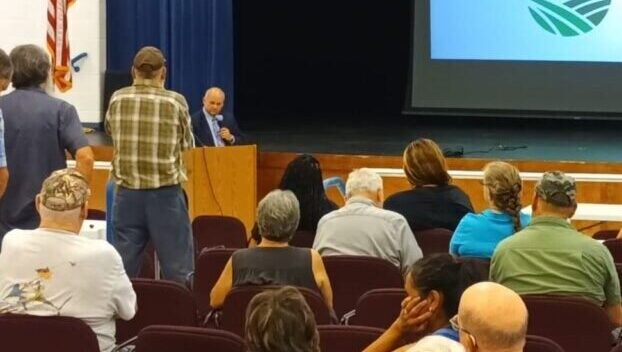‘Something is missing’: Residents challenge Green Ridge promises
Published 12:08 am Sunday, August 11, 2024
|
Getting your Trinity Audio player ready...
|
Muriel Branch raised a question during the meeting. Branch, the president of the AMMD Pine Grove Project, pointed out that Green Ridge said the proposed Cumberland landfill wouldn’t expand, and yet in the paperwork, the current project is identified as the “initial phase”. That, as she pointed out, implies there are more phases to come.
“When you use the word initial, and when you use the word conditional, conditional means that something is not complete,” Branch said. “Something is missing. Something still needs to be done. And we don’t see any tangible evidence that the promises you’re making to us have any regulatory teeth in them.”
And that discussion summed up the meeting between Cumberland residents and representatives of Green Ridge Recycling and Disposal, held on Monday, Aug. 5. Residents said they heard what company officials were promising, but in each case, how could they guarantee anything that’s not in writing? Company officials meanwhile outlined multiple adjustments they’ve made to the project, saying they would be willing to include them in the final conditional use permit request. But again, as residents pointed out, that’s a promise, not a contract.
What changes with Green Ridge?
Trending
The major part residents came to hear is the discussion about what would be changing before Green Ridge goes to the county and requests a conditional use permit. The 1,200 acre site will now only have 104 acres of active disposal area, down from 500 acres originally. The current plan also includes about 200 acres for operations and then the remaining space will serve as a buffer.
The amount of waste being hauled in was also dramatically reduced, as part of the Virginia Department of Environmental Quality’s “Part A” process. Getting Part A approval is what’s considered an “entrance exam” of sorts, DEQ officials say. It’s not commenting on the design, proposed location or anything of that nature. It’s simply saying that as presented, it would work as a landfill.
Originally, Green Ridge proposed bringing in 5,000 tons a day of garbage. That’s been dropped back in the Part A process to 1,500 tons a day. The number of waste–hauling trucks has also been cut back, down to 75 a day. Another big change is the planned hours of operation. Originally, this was going to be a 24-hour 7-day a week operation. Under the changes, it would be open from 6 a.m. to 4 p.m. Monday through Friday, 6 a.m. to noon on Saturday and closed on Sunday.
“It would also have a convenience center, for Cumberland residents to have their waste dropped off,” said Will Shewmake, an attorney with the Norfolk-based law firm Woods Rogers. He led the Aug. 5 meeting, identifying changes and answering questions.
To cut down on odor, the landfill also won’t accept sludge, processed construction debris or flyash for waste disposal.
Promises versus contracts
One thing that is in writing, included in the Part A permit, is a change to where the waste comes from.
Trending
“One of the big issues is will it take out of state waste? It’s one thing to say we’re going to serve Virginia residents but what were the guarantees,” Shewmake said. “As part of the DEQ permitting process, we have put in that this landfill will only accept Virginia waste.”
He added that roughly 80% of that would come from the Central Virginia area. However, residents pointed out that all Shewmake and Green Ridge in general can promise is that the trash comes from Virginia sites. They have no control over if say a Maryland group or a D.C. group hauls trash and dumps it at a Virginia site.
Shewmake also said the company would put it in the conditional use permit that they will not relocate Pine Grove Road.
What about water?
Other residents were concerned about water usage. Most of the 37 homes nearby use shallow wells. So what happens to them when the landfill starts drawing water? Shewmake argued that as new homes get built in the area, they’re more likely to affect the residential wells than the proposed landfill. However, he said they would take a look at the area and determine if they need to drill deeper, as part of their current design analysis.
Another repeated concern was about the liner. A landfill liner’s purpose is to be placed beneath and around the waste pile, to prevent any toxic liquid waste from leeching into the soil and groundwater.
“I’ve seen what happens when large companies come into an area,” said Mike Green. “How much money have you set aside to compensate (residents) when a liner breaks and people lose their wells?”
William Jones echoed that question, pointing out the liner is often not much larger than a trash bag. Shewmake said the company would use double composite liners, a thicker version, even though it’s not required, and would be willing to put that in the conditional use permit.
What happens next with Green Ridge?
This isn’t anywhere near even going to Cumberland supervisors yet. The project has made it through Part A of the approval process and now goes into Part B. That’s where they go over the design with state officials, along with the liner system, stormwater management and even a post closure plan for down the road. Also, what would all those trucks do to Pinegrove Road? The Virginia Department of Transportation will have to sign off on that as well.
Then, once all that is done, if they get approval by the state, it’ll be time to come before Cumberland supervisors and ask for that conditional use permit.






